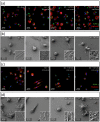Nanotopographical Coatings Induce an Early Phenotype-Specific Response of Primary Material-Resident M1 and M2 Macrophages
- PMID: 32143448
- PMCID: PMC7084960
- DOI: 10.3390/ma13051142
Nanotopographical Coatings Induce an Early Phenotype-Specific Response of Primary Material-Resident M1 and M2 Macrophages
Abstract
Implants elicit an immunological response after implantation that results in the worst case in a complete implant rejection. This biomaterial-induced inflammation is modulated by macrophages and can be influenced by nanotopographical surface structures such as titania nanotubes or fractal titanium nitride (TiN) surfaces. However, their specific impact on a distinct macrophage phenotype has not been identified. By using two different levels of nanostructures and smooth samples as controls, the influence of tubular TiO2 and fractal TiN nanostructures on primary human macrophages with M1 or M2-phenotype was investigated. Therefore, nanotopographical coatings were either, directly generated by physical vapor deposition (PVD) or by electrochemical anodization of titanium PVD coatings. The cellular response of macrophages was quantitatively assessed to demonstrate a difference in biocompatibility of nanotubes in respect to human M1 and M2-macrophages. Depending on the tube diameter of the nanotubular surfaces, low cell numbers and impaired cellular activity, was detected for M2-macrophages, whereas the impact of nanotubes on M1-polarized macrophages was negligible. Importantly, we could confirm this phenotypic response on the fractal TiN surfaces. The results indicate that the investigated topographies specifically impact the macrophage M2-subtype that modulates the formation of the fibrotic capsule and the long-term response to an implant.
Keywords: combination of physical vapor deposition and electrochemical etching; defined humanized test system; inflammatory response; nanotopographical surfaces.
Conflict of interest statement
The authors declare no conflict of interest.
Figures







Similar articles
-
Macrophage phenotype switch by sequential action of immunomodulatory cytokines from hydrogel layers on titania nanotubes.Colloids Surf B Biointerfaces. 2018 Mar 1;163:336-345. doi: 10.1016/j.colsurfb.2018.01.007. Epub 2018 Jan 9. Colloids Surf B Biointerfaces. 2018. PMID: 29331905
-
Dual-inflammatory cytokines on TiO2 nanotube-coated surfaces used for regulating macrophage polarization in bone implants.J Biomed Mater Res A. 2018 Jul;106(7):1878-1886. doi: 10.1002/jbm.a.36391. Epub 2018 Mar 30. J Biomed Mater Res A. 2018. PMID: 29524297
-
The role of macrophage polarization on fibroblast behavior-an in vitro investigation on titanium surfaces.Clin Oral Investig. 2018 Mar;22(2):847-857. doi: 10.1007/s00784-017-2161-8. Epub 2017 Jul 14. Clin Oral Investig. 2018. PMID: 28707226
-
Anodic TiO2 Nanotubes: Tailoring Osteoinduction via Drug Delivery.Nanomaterials (Basel). 2021 Sep 11;11(9):2359. doi: 10.3390/nano11092359. Nanomaterials (Basel). 2021. PMID: 34578675 Free PMC article. Review.
-
Titanium Nitride Coated Implant Abutments: From Technical Aspects And Soft tissue Biocompatibility to Clinical Applications. A Literature Review.J Prosthodont. 2022 Aug;31(7):571-578. doi: 10.1111/jopr.13446. Epub 2021 Nov 20. J Prosthodont. 2022. PMID: 34731520 Review.
Cited by
-
Superhydrophobicity Effects on Spheroid Formation and Polarization of Macrophages.Pharmaceuticals (Basel). 2024 Aug 7;17(8):1042. doi: 10.3390/ph17081042. Pharmaceuticals (Basel). 2024. PMID: 39204146 Free PMC article.
-
Nano-Roughness-Mediated Macrophage Polarization for Desired Host Immune Response.Small Sci. 2023 Aug 13;3(10):2300080. doi: 10.1002/smsc.202300080. eCollection 2023 Oct. Small Sci. 2023. PMID: 40213139 Free PMC article.
-
Effects of bone surface topography and chemistry on macrophage polarization.Sci Rep. 2024 Jun 3;14(1):12721. doi: 10.1038/s41598-024-62484-3. Sci Rep. 2024. PMID: 38830871 Free PMC article.
References
-
- Brodbeck W.G., Patel J., Voskerician G., Christenson E., Shive M.S., Nakayama Y., Matsuda T., Ziats N.P., Anderson J.M. Biomaterial adherent macrophage apoptosis is increased by hydrophilic and anionic substrates in vivo. Proc. Natl. Acad. Sci. USA. 2002;99:10287–10292. doi: 10.1073/pnas.162124199. - DOI - PMC - PubMed
Grants and funding
LinkOut - more resources
Full Text Sources

